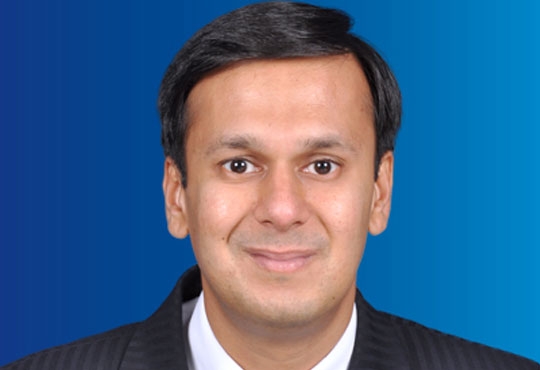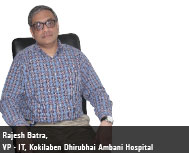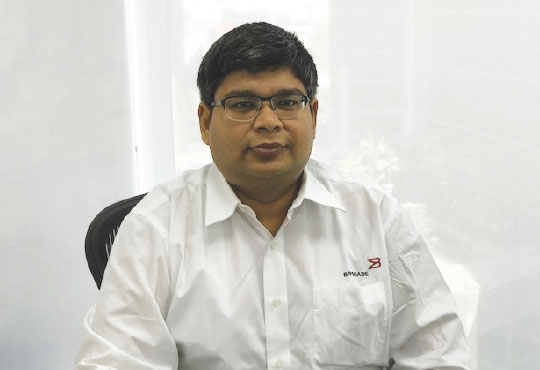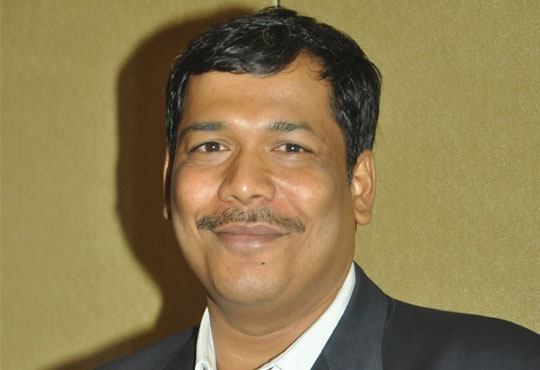
CIOTechOutlook >> Magazine >> November - 2015 issue
Mobility- Revamping the face of Healthcare Industry
By
 Kokilaben Dhirubhai Ambani Hospital, headquartered in Mumbai, is a social initiative by Reliance Group. The hospital specializes in Brain & Nervous System, Cancer treatment, Cardiac Sciences, Cosmetology & Plastic Surgery, Physical Medicine & Rehabilitation, Transplant and Robotic Surgery
Kokilaben Dhirubhai Ambani Hospital, headquartered in Mumbai, is a social initiative by Reliance Group. The hospital specializes in Brain & Nervous System, Cancer treatment, Cardiac Sciences, Cosmetology & Plastic Surgery, Physical Medicine & Rehabilitation, Transplant and Robotic Surgery Healthcare is a sunshine industry and has come into focus in recent times. More and more funding is being made available to this sector. Healthcare will actually benefit right from Patient appointments to Doctors consulting and sending/receiving diagnostic reports from the influx of ICT and the focus thereby coming. And have follow up visits to reminders for visits to remote monitoring, all with the ICT influx. All this technology is available is nascent stages currently. Mobility in helping doctors make reports and notes on patient's bedside and have them place medication order to diagnostic. The possibilities are endless and the sector is starting to explore them now. The concept of healthcare mobile solutions is evolving and in the recent years more so.
To understand, we would need to go back 20 years in manufacturing industry. It was disparate and evolving in processes and quality. ERP's were evolving for the industry. Today Manufacturing processes and quality have evolved and ERP's are considered a standard for manufacturing industry. Not only that, ERP’s have a localization packed for every country. I remember going through MRP to MRP II and when finance and HR was integrated to manufacturing the word ERP evolved. We are experiencing the same shift in Healthcare today. It will be interesting to see how the processes and quality standards evolve in the coming few years to take it to a mature industry.
I have seen some organizations allowing doctors to view EMR on their tablet and encrypt the data to protect privacy and dignity. Whereas some organizations are outward focus and giving more to the patient. Some
allow pathology and radiology reports to be downloaded. Then there are companies tying up with telecom providers to be the middleware to integrate devices with hospital systems. These devices through smart phones , monitor patients and send data to the hospital and alert the doctor to an abnormal value.
M2M aka machine to machine method for remote monitoring is currently focused on elderly home care and patients with certain cardiac issues. However, having said that, the simplest thing which is happening is PACS (Picture Archival and communication System aka digital Radiology) is going mobile in modern digital hospitals. This will allow doctors to view radiology images on their hand-helds. In my view the bigger beneficiaries will be neurologists, cardiologists and orthopedics as during emergencies such as road accidents, they can have access to brain scans reports, angiographs, bone x-rays etc. and further helping them to take decisions in split seconds.
The other trends which are making inroads into modern hospitals are Health Cards and RFID tags. These Health cards are coming with a chip, which are keeping the patient records in the card. However, the cost of card is still high and adoption has been low. Moreover, the doctors esp. the earlier generation have keyboard phobia and still don't enter the details of the patients during IP stay. And not only that, patients prefer paper prints, as they feel more comfortable with them and they can take the records to their physician of choice for a second opinion, thereby presenting a double edged sword to the Healthcare IT specialists to adopt or not to adopt.
The other trend which is coming in slowly is RFID tags. These are being tried with patient bands during their stay in the hospital and on mobile capital assets. The challenge a few years ago was the ability of Wi-Fi access points' ability to capture the data on the fly with the movement of the patient and the capital asset. And areas like ICU and OT's still do not have Wi-Fi points as the Medical equipments interfere in the frequencies causing aberrations in the Wi-Fi output.
And then we are going to see things like Beacons coming into hospital to guide patients and relatives to move around the hospital. The other trend which might catch on is heat maps. Heat Maps are being used by mobile towers and Google to predict congestion and traffic movements on Indian roads in most major cities. However, these are moving into Malls to analyze foot falls in what sections etc. This technology may come inside the hospitals to help analyze the foot traffic and to smooth flow of patients and relatives. But this is on the thought process currently and malls are doing the hard work currently.
CXO Insights
The Potential Impact of GST on ERP
By Ashwin P. Kelkar, Partner - IT Advisory, KPMG India
Digital Transformation Driving Modern...




